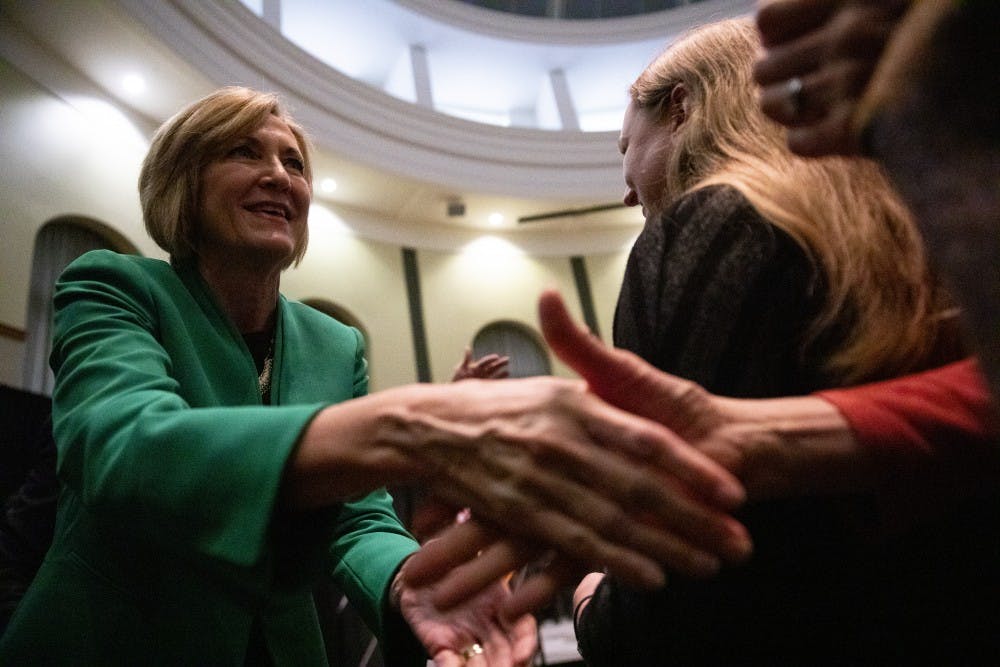Taylor Sappington, a Democrat running for the Ohio Statehouse, is one of many candidates running for office who may change the face of politics in Ohio — and across the nation — if elected Nov. 6.
Ballots across the U.S. feature a record number of LGBT and female candidates, and Ohio’s slate is no different. Sappington and U.S. House candidate Rick Neal are just two of the 392 openly LGBT candidates running across the nation.
“For me personally, it would mean a lot to win this seat and not only represent LGBT issues, but southeast Ohio and Appalachia,” Sappington said. “To run as an openly gay man on the same ticket as Rick Neal, an openly gay man running for Congress in my district, really is kind of extraordinary.”
In addition to the slate of LGBT candidates, there are more than 1,000 women running for state and federal offices in the U.S. — including 11 U.S. House candidates, Ohio Lieutenant Governor candidate Betty Sutton and Ohio Secretary of State candidate Kathleen Clyde.
“We need to run on the strength of our candidates and our ideas,” Clyde said. “I think many voters are ready for a change, and I think that's what we will see in this election.”
Clyde said she is glad to see more women running across the country. She said she thinks people look at her accomplishments and qualifications rather than her gender because it shouldn’t be important.
Women, LGBT people and most minorities are considered widely underrepresented in U.S. government. Women make up 50.8 percent of the U.S. population but only fill 107 of the 535 seats in the House and Senate. Meanwhile, there are just 7 openly LGBT representatives in Congress’ two chambers.
Sappington said representation is important at all levels of government and necessary so that members of legislative bodies, like the Statehouse and Congress, have a wide range of identities, personalities and backgrounds.
Neal and Sappington both said they believe a big reason more diverse candidates are running for office this year is that many people are upset with the current government. Both believe the dysfunction and inaction at both the state and federal levels need to be fixed.
“I think it is largely a reaction to the Trump administration and supporters of Trump in other offices,” Katherine Jellison, a history professor at Ohio University, said. “Women and LGBT folks feel under siege in this era and feel that their rights and their dignity are at risk and want to push back against that.”
Jellison said she believes people who have felt unempowered are doing better at organizing and mobilizing to get out the vote.
Neal, like many other minority candidates, has a chance to make history: If he wins his election against incumbent Steve Stivers, R-Upper Arlington, he would become Ohio’s first openly LGBT federal representative.
Prior to running for lieutenant governor, Sutton became the first woman elected as a legislator at the city, county, state and federal levels. At a rally Thursday attended by Sen. Elizabeth Warren, D-Mass., Sutton said she is a real Ohio story because she grew up here and held all those positions.
“It's a unique time, but that’s not to say that we have solved all the problems that need to be addressed, but it's the start of bigger things to come,” delfin bautista, the director of OU’s LGBT Center, said.
If these minority candidates win, the election could see a “rainbow wave” of LGBT winners or a “pink wave” of female winners across federal, state and local races. Some of these candidates face uphill battles against incumbents, but many others are running in more winnable races.
“There are a lot of stereotypes about Ohio and Ohio not being a very welcoming state, and part of that is grounded in reality and part of it is misunderstandings,” bautista who uses they/them pronouns and the lowercase spelling of their name, said. “Not that having an elected official makes everything perfect, but it's one of many things that will show LGBT people here in Ohio that our lives and our voices matter.”
The Human Rights Campaign puts out a scorecard for each congressional representative’s voting record on LGBT-related legislation. That scorecard gives only seven of the 18 current Ohio representatives in the Senate and House a score higher than a zero. Among the representatives with a zero is Stivers, Neal’s opponent.
Both Neal and bautista said having these candidates — or more candidates who are supportive of minorities — in office would help pass legislation to provide protections and equal rights at the state and federal levels.
“Now, it's time to bring some new perspectives that reflect the greater diversity of the American population and bring a point of view that says there are other perspectives and experiences out there besides the usual default white, straight, male perspective,” Jellison said.






